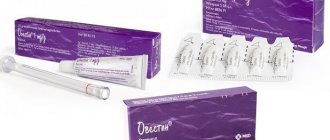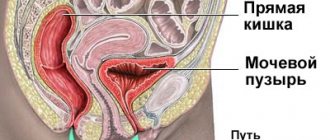Pharmacological properties of the drug Dostinex
A dopaminergic ergoline derivative with a pronounced and long-lasting prolactin-lowering effect. The drug inhibits prolactin secretion by directly stimulating D2-dopamine receptors in lactotrophic pituitary cells. In addition, when taken in higher doses than those used to reduce prolactin secretion, cabergoline has a central dopaminergic effect due to stimulation of D2 receptors. A decrease in the level of prolactin in the blood plasma is observed 3 hours after taking the drug orally and persists for 7–28 days in healthy volunteers and patients with hyperprolactinemia and up to 14–21 days when taken to suppress postpartum lactation. Dostinex is rapidly absorbed from the digestive tract, the maximum concentration in the blood plasma is reached after 0.5–4 hours. Food intake does not affect the absorption and distribution of cabergoline. The half-life, estimated from the rate of urinary excretion, is 63–68 hours in healthy volunteers and 79–115 hours in patients with hyperprolactinemia. Due to the long half-life, steady state is achieved after 4 weeks. About 41–42% of the drug binds to blood plasma proteins.
pharmachologic effect
Cabergoline is an ergot derivative characterized by an intense, long-lasting hypoprolactinemic effect. The active substance directly stimulates dopamine receptors located in the lactotropic cells of the pituitary gland. When taken in quantities exceeding therapeutic levels for the correction of prolactin levels, a central dopaminergic effect is observed.
The concentration of prolactin in the patient’s body decreases within 3 hours from the moment of use of the drug. The effect of the Dostinex tablet lasts from 1 to 4 weeks in healthy study participants and women with hyperprolactinemia, from 2 to 3 weeks in women after childbirth.
The drug is distinguished by its selectivity of action and does not change the process of synthesis of other pituitary hormones. The severity of the effect and its duration depend on the dosage.
The drug also reduces blood pressure, which manifests itself in a dose-dependent manner over the next 6 hours after administration.
Indications for use of the drug Dostinex
Prevention/suppression of physiological lactation. Prescribed to prevent physiological postpartum lactation or suppress established lactation. Treatment of hyperprolactinemia. Dostinex is also prescribed for the treatment of hyperprolactinemia, manifested by menstrual irregularities (amenorrhea, oligomenorrhea, anovulation), infertility, galactorrhea in women or impotence, decreased libido in men. Dostinex is indicated for the treatment of patients with prolactin-secreting pituitary adenomas (micro- and macroprolactinomas), idiopathic hyperprolactinemia or empty sella syndrome, which are the main pathological conditions associated with hyperprolactinemia.
Be prepared for leaks!
Even after the cessation of lactation or in its last stages, unexpected copious discharge of milk from the breast is possible. This can happen when hugging a partner, when having sex with him, when being sexually aroused, when thinking about a child, when touching the breast. To prevent unexpected milk leaks, wear absorbent pads in your bra. Keep a spare supply of such gaskets with you. Wear dark-colored tops so that milk stains are not as noticeable. Take a spare set of clothes with you, especially for more important occasions.
Express some milk before leaving the house. If you feel milk leaking, cross your arms over your chest to stop the flow.
In all cases, get advice from a breastfeeding specialist on how best to stop lactation in your case.
Use of the drug Dostinex
To prevent postpartum lactation, 1 mg is prescribed once on the first day after birth; to suppress established lactation - 0.25 mg (1/2 tablet) every 12 hours for 2 days. Treatment of hyperprolactinemia: Dostinex is taken 1-2 times a week (for example, on Monday or Monday and Thursday). You should start taking it with lower doses - 0.25 mg (1/2 tablet) or 0.5 mg (1 tablet) per week and, if necessary, increase the dose depending on the therapeutic effect and tolerability. The weekly dose should be increased gradually - by 0.5 mg at monthly intervals. Typically the therapeutic dose is 1 mg/week and can range from 0.25 to 2 mg/week. Doses up to 4.5 mg/week have been used to treat patients with hyperprolactinemia. A dose of 1 mg per week or higher should be taken in 2 divided doses (or more often) depending on tolerance. When establishing the dose, it is necessary to examine the patient to determine the minimum effective therapeutic dose. After an effective dosage regimen has been selected, it is advisable to regularly (once a month) determine the level of prolactin in the blood serum. Normalization of prolactin levels is usually observed within 2–4 weeks of treatment.
Popular questions about Dostinex
Why is Dostinex prescribed?
Experts recommend buying Dostinex for the treatment of hyperprolactinemia caused by various conditions, the prevention of physiological lactation after childbirth and the interruption of established lactation.
How quickly does the effect of Dostinex occur?
The effect of the drug is observed within 3 hours after use.
How to use Dostinex correctly?
Dostinex, the price of which is affordable in Ukraine, must be used strictly according to the scheme drawn up by the attending physician, taking into account the severity of the pathology and the individual characteristics of the body.
How long can you take Dostinex?
The duration of the course of treatment is determined by the doctor.
Side effects of the drug Dostinex
Dostinex is usually well tolerated. When used to prevent and suppress lactation, the most common symptoms observed are a decrease in blood pressure, dizziness, nausea, headache, insomnia, and abdominal pain (in most cases, these phenomena are mild and short-lived). When treating hyperprolactinemia, the most common symptoms are nausea, headache, decreased blood pressure, dizziness, abdominal pain, dyspepsia, gastritis, general weakness, constipation, breast tenderness, hot flushes, depression, paresthesia. Typically, these symptoms are moderate or mild, appear during the first 2 weeks of use and then go away on their own. When Dostinex is discontinued, unwanted reactions disappear within a few days. Side effects of the drug are dose-dependent. In case of severe or persistent side effects, a temporary dose reduction followed by a gradual increase (for example, by 0.25 mg/week for 2 weeks) is necessary.
Note!
The description of the drug Dostinex on this page is a simplified author’s version of the apteka911 website, created on the basis of the instructions for use.
Before purchasing or using the drug, you should consult your doctor and read the manufacturer's original instructions (attached to each package of the drug). Information about the drug is provided for informational purposes only and should not be used as a guide to self-medication. Only a doctor can decide to prescribe the drug, as well as determine the dose and methods of its use.
Special instructions for the use of Dostinex
Are common. As with other ergot alkaloids, Dostinex is used with caution in patients with severe cardiovascular disease, Raynaud's syndrome, stomach ulcers or gastrointestinal bleeding, or with a history of severe mental illness. Liver failure. In patients with severe liver failure who use Dostinex for a long time, the lowest doses should be used. In patients with severe hepatic insufficiency (Child-Pugh class C) who used a single dose of 1 mg, an increase in AUC was observed in contrast to healthy individuals and patients with mild forms of hepatic insufficiency. Postural hypotension. During the period of Dostinex use, patients experienced postural hypotension. Therefore, it should be used with caution with drugs that lower blood pressure. Fibrosis/valvulopathy. Cases of pleural effusion/pulmonary fibrosis and valvulopathy have been reported in patients using ergot derivatives, including long-term use of cabergoline. Some cases involved patients who had previously used dopamine agonists. Therefore, it is not recommended to use the drug in patients who currently have clinical symptoms (or a history of them) of respiratory and cardiovascular diseases associated with tissue fibrosis. It is known that in patients who used Dostinex, pleural exudate or fibrosis may appear against the background of an increase in ESR. If there is an unmotivated increase in ESR, patients are recommended to undergo an X-ray examination of the lungs. Determination of serum creatinine levels can also be used as an auxiliary method in the diagnosis of fibrotic diseases. Discontinuation of cabergoline in the event of pleural effusion, pulmonary fibrosis or valvulopathy leads to regression of clinical symptoms. Before starting cabergoline treatment, all patients are recommended to undergo a cardiac examination, including an echocardiogram, to assess the presence of latent forms of heart valve pathology. In the future, it is recommended to regularly conduct clinical diagnostics to monitor the development of valve disease or fibrosis (physical examination, radiography, echocardiography, CT scan). Sleep disturbance/sudden falling asleep. The use of cabergoline causes drowsiness. Dopamine agonists may cause sudden sleep onset in patients with Parkinson's disease. If such cases occur, it is necessary to reduce the dose or discontinue treatment. Prevention/suppression of physiological lactation. By analogy with other horn drugs, Dostinex can be used by patients with hypertension, pregnancy-induced preeclampsia or postpartum hypertension, only in cases where the benefits of using the drug outweigh the possible risks. A single dose of 0.25 mg of Dostinex should not be exceeded in women during postpartum lactation (if it is suppressed) to prevent postural hypertension. Treatment of hyperprolactinemia. Before starting treatment for hyperprolactinemia with Dostinex, it is necessary to diagnose the pituitary gland. The drug restores ovulation and fertility in women with hyperprolactinemic hypogonadism, therefore it is recommended to carry out a pregnancy test every 4 weeks during the amenorrhea period and after each restoration of menstruation if their delay is more than 3 days. Women are recommended to use mechanical contraception during Dostinex therapy and after its discontinuation until anovulation returns. Women who have become pregnant should be constantly monitored for symptoms of pituitary enlargement, since the clinical manifestations of a pituitary tumor may return. Mental disorders. In patients who use dopamine receptor antagonists, including Dostinex, cases of the development of a pathological tendency to gambling, increased libido and hypersexuality have been recorded. These effects are usually reversible after discontinuation of therapy. The ability to influence the reaction rate when driving a vehicle or working with other mechanisms. Patients using cabergoline who are prone to drowsiness should be advised to refrain from driving or performing activities that require alertness, except in patients who are able to overcome episodes of drowsiness, due to the risk of serious injury. or even the death of the patient or others.
How to quickly stop lactation?
The speed of cessation of lactation depends on a number of factors:
- The baby's age and the amount of milk produced.
- Stage of pregnancy when it is terminated (lactation is possible after termination of pregnancy after the 18th week).
- The amount of milk expressed, milk flowing out.
- Pressure on the nipples (during work, sports, sex).
- Presence of next pregnancy.
Some mothers take weeks to stop breastfeeding. For others, the process takes only a few days. However, milk stains on your bra can sometimes be noticed several months or even years after you think that lactation has stopped: for each mother, the process of stopping lactation occurs individually.
Interactions of the drug Dostinex
No interaction was observed with concomitant therapy with methylergonovine maleate in early pregnancy. Despite the fact that there is no data on the interaction of Dostinex with other ergot alkaloids, the simultaneous administration of these drugs for a long time is not recommended. Since the effect of Dostinex is realized through direct stimulation of dopamine receptors, simultaneous administration of dopamine antagonists (for example, phenothiazines, butyrophenones, thioxanthenes, metoclopramide) is not recommended, since this may reduce the clinical effectiveness of Dostinex. When taking Dostinex, symptomatic arterial hypotension may develop, so Dostinex should be prescribed with caution simultaneously with other drugs that lower blood pressure.
Call a breastfeeding specialist to your home
At the Group’s children’s medical centers, we know that the most convenient place for breastfeeding consultations is your own cozy home:
- A specialist will come to you at a convenient time. You don't have to go to the clinic and wait in line. Consultations can also be held directly in the maternity hospital (if visits are permissible) or in a medical center.
- A familiar home environment makes consultation easier for both mother and child.
- At home, the consultant will be able to devote more time to both the child and the parents.
- The consultant is always a phone call away: day and night (at night you can call the contact center or write to the consultant, the consultant will answer as soon as possible), on weekdays and on weekends.
- Support from a specialist is not one-time consultations, but accompaniment: the consultant will visit the mother and baby again, if necessary, after 2-4 weeks to check how feeding is going and the baby’s weight gain.
In addition to calling a breastfeeding specialist to your home, you can call doctors of the main specialties: pediatrician, surgeon, allergist, urologist, pulmonologist, hematologist, dermatologist, ophthalmologist, ENT doctor, orthopedist, gastroenterologist and osteopath. You can also take tests, perform physiotherapy and massage at home. Infant swimming consultants can advise you at home and conduct a master class.
Find out about the special offer “Comprehensive examination at home”: the convenience of this program is that you can choose from a list of pediatric doctors exactly those specialists that your child needs and an individual set of medical services with a 20% discount!







